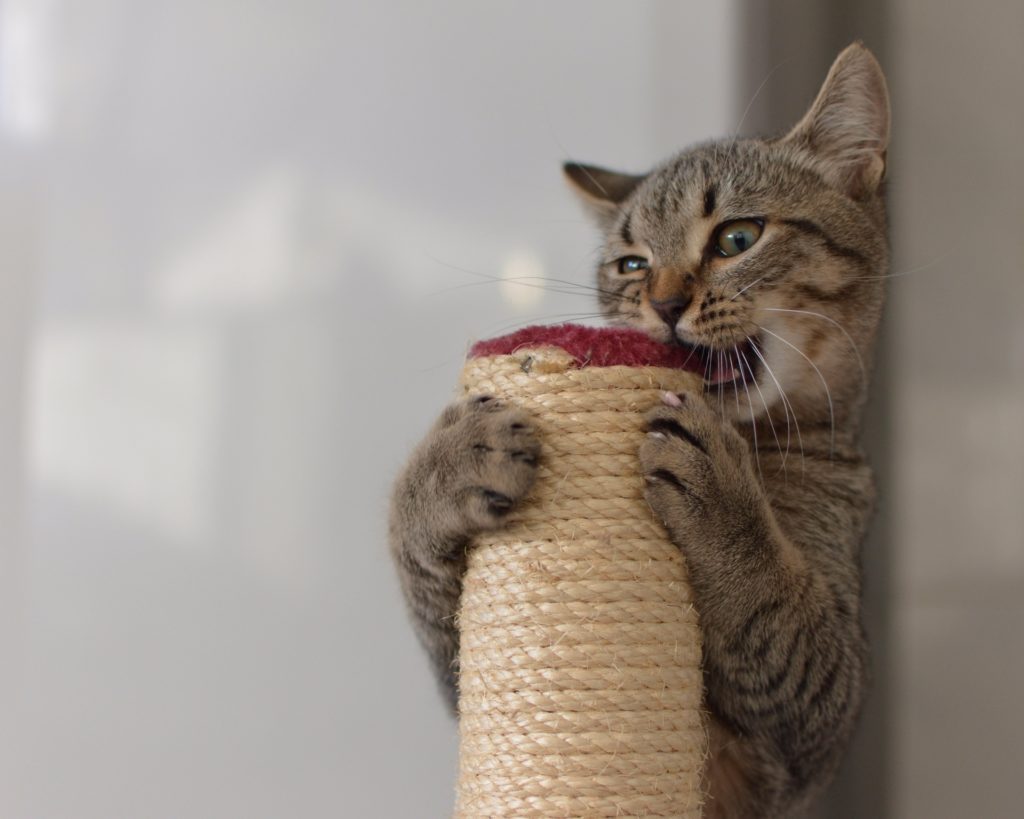It is natural for cats to scratch inanimate objects. They scratch to sharpen their nails, dislodge old nail growth, scent mark their territory and stretch their limbs. They do not scratch your favorite couch or rug to be spiteful. Although this behavior can be quite upsetting to even the most devoted cat lover, at Animal Medical Center of Chicago we do not recommend the quick fix solution of surgically declawing your cat. We believe that you can live harmoniously with your cat and their claws if you follow these six recommendations:
- Environmental Enrichment
Undesirable cat scratching can be due to boredom. Like babies who cry for a parent’s attention, a cat may scratch out of a need for more social interaction or stimulation. Some examples of environmental enrichment ideas include; hiding food around the home for them to find, placing food or treats in cat activity boards or in food dispensing balls, playing chase-the-laser tag, access to windows for outside viewing, high perches for them to rest and observe, and hiding places.
Although some people mistakenly believe cats are independent, most cats seek out human interactions. We encourage you to spend quality time with your cat each day – this may be simply petting or snuggling with your cat.
- Cat Scratching Post and Scratching Pads
How many of you have purchased a cat scratching post and your cat ignored it? Cats can be very picky! It’s important to make sure you get the right scratching post or pad, made with the right material and size for your finicky cat. Experiment with different options. Our favorite cat scratching post is made with sisal rope placed in a vertical direction. Cardboard scratchers that you sprinkle with catnip are also very popular with most scratching cats.
Not only is the design of the scratching post important, but also their placement in your home. Since cats like to stretch immediately after waking up, place the scratcher near it’s favorite sleeping spot. This will improve its chance of use. Another great location is immediately next to where you do NOT want them to scratch. We recommend that you apply the territory pheromone FeliScratch on the new scratching post and spray the calming pheromone Feliway on the place you do NOT wish them to scratch. Both of these products can be purchase at AMCOC or online.
Also, do not place scratching posts or pads near high traffic or noisy areas in the home. Cats prefer quiet spots to scratch.
- Immediate Positive reinforcement
Positive reinforcement can also go a long way towards eliminating this undesirable scratching of furniture. If your cat is scratching an area you don’t want them to, simple pick them up and relocate them to the scratcher and reward them with a treat. Never physically or verbally punish them. This will create a fearful, stressed cat and may increase the frequency of scratching in your home. On the other hand, if you catch them using the scratcher, instantly reward them with a tasty treat. Starting kittens on scratchers when they are young tends to lead to greater future compliance.
- Regular Nail Trimmings
Regular nail trimming can prevent your cat’s nails from splintering and being used as weapons. Proper trimming can also prevent piercing and damage of household items. The frequency between trimmings depends on your cat’s lifestyle, but most indoor cats will require a nail trim at least once every 3-4 weeks. If you need assistance, please call us at 773-525-3353 to schedule a technician appointment to show you how to trim your cat’s nails. With practice, you can master this task at home. If you have a non-compliant cat, please ask us about a calming agent, called Gabapentin. This medication can be given 1 hour before a nail trim and it makes many cats relaxed and tolerant to a nail trim at home or at our clinic.
If you have a kitten, start practicing nail trims as early as possible. Always make sure your cat is calm during the nail trim. If they become stressed, take a break and try again later. Don’t hesitate to call us for assistance!
- Temporary Synthetic Nail Caps
These are protective plastic caps that are glued over your cat’s own nails to help reduce damage to household items. Typically, they need to be reapplied every 4-6 weeks by you or your groomer. Unfortunately, not all cats will tolerate synthetic nail caps. The product we recommend is called Soft Paws and is available online to order.
- Anti-Anxiety Medications, Synthetic Facial Pheromone Sprays and diffusers.
Stress, anxiety and fear in a cat household can increase undesirable scratching. Please call us to discuss this in more detail. If we deem medically appropriate, we may recommend an anti-anxiety medication, called fluoxetine, for your cat.
If you have multiple cats in your home, make sure everyone has their own litterbox, resting spot and food bowl. These all should be easily accessed by each cat without being challenged or blocked by a threatening cat.
To help reduce stress in the home, we may also recommend the use of a synthetic facial pheromone diffuser, called Feliway. This product is available at AMCOC or online.
Remember, cat scratching is part of a cat’s normal behavior and declawing should not be the answer to eliminating this behavior in your home. It may take some time and perseverance, but we hope, by following these recommendations you and your cat can learn to live in harmoniously together.
For additional questions about alternatives to cat declawing, please contact the staff at Animal Medical Center of Chicago at 773-525-3353. You can also find us on the web at amcchi.com or email staff@amcchi.com


